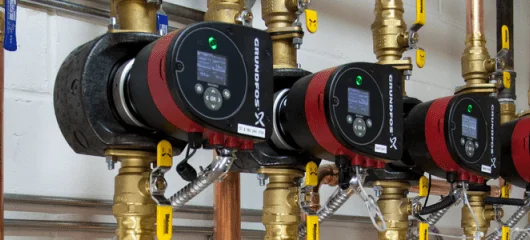Many thermostatic mixing valve manufacturers, including Caleffi, specify minimum GPM flow rates for their thermostatic mixing valves, to assure control accuracy at the low end, but don't always specify a maximum flow rate. Instead, a graph showing flow rate versus pressure drop is shown in the literature. You might be tempted to look at the top end of the graph and assume that to be the maximum flow rate for the valve; don't do that. Sure, maybe the valve COULD deliver that high GPM, at that pressure drop, but those conditions may be unreasonable, and unadvised because of the excessive velocity and potential noise and erosion. So, back to the question, what's the maximum flow rate?
Here is a good reference from the Copper Development Assocation: "The recommended maximum velocity for water in a copper tube system is 5 - 8 feet per second (fps) for cold water systems, 4 - 5 fps for hot water systems < 140º F, and 2-3 fps for hot water systems with a temperature greater than 140º F." So, for example, 5 fps in a 1/2" copper pipe = 4.0 GPM. In a 3/4" copper pipe, 8.1 GPM and in 1" copper = 13.6 GPM. Keep this in mind when sizing and selecting your valve.
In the Technical Brochure for the Caleffi 521 Series MixCal valve, we specify a maximum recommended differential pressure of 20 PSID, which, according to the graph in our literature equates to about 15 GPM. So if you select a 1" 521 MIxCal for a domestic hot water 1" copper pipe and your maximum design flow is ~13 to 14 GPM, you'll be in line with the CDA reference, and the differential pressure across the 1" MixCal will be ~15 PSID, just right!






Very useful tutorial, but the link to Caleffi Mixing Valve was non-existent for me on 08 Feb 2021. Had hoped to see some graphs (charts) compliment the text.
Your ref: https://www.caleffi.com/usa/en-us/blog/what-maximum-flow-rate-thermosta…
In reply to Very useful tutorial, but the by David Moore
David, Thank you i went in and repaired the link. Here it is again for you to review. 521 technical brochure